| Pain on Your Plate |
| Part II - The Hazards of Meat Eating |
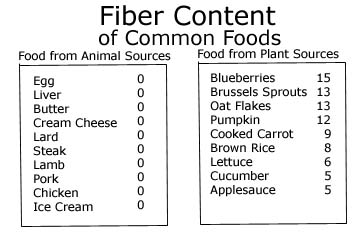
The nature of our intestines requires fiber to move things along.
Fiber acts like a broom to sweep our bowels clean.
This chart shows the fiber content of various foods.
Notice that animals and animal byproducts have none.
It's bad enough that meat lacks fiber, what makes it worse is that animal fat
solidifies at body temperature: slowing down the digestive process and
causing the body to absorb more of the poisons that were injected into the animals at the factory-farm.
|
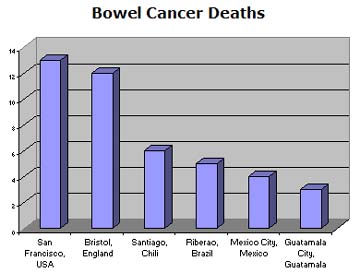
If we were carnivores, meat wouldn't be a health problem for us (if it weren't laced with drugs.)
But the fact that we don't have the bowels of a carnivore is driven home by this chart
showing bowel cancer deaths amongst various populations from San Francisco to Guatemalla.
Compare this chart with...
|
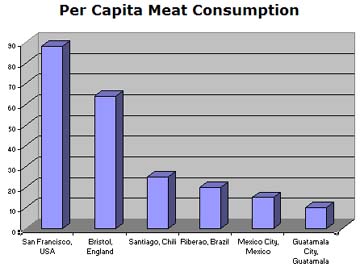
...the per-capita meat consumption of those same populations.
Every study undertaken on this subject has shown that wherever there is a high level of meat consumption
there is a high incidence of bowel cancer.
|
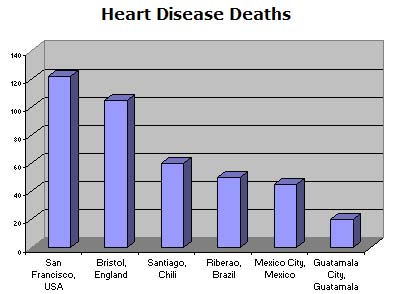
But our bowels aren't the only thing that meat clogs.
Thanks to its cholesterol content, meat clogs our arteries,
leading to the heart disease deaths shown here.
Our bodies produce all of the cholesterol we need:
there has never been a case of someone suffering from a deficiency of cholesterol.
So eating any cholesterol is eating an excess.
|
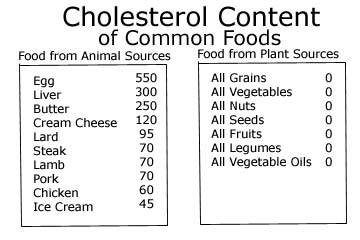
This chart shows which foods contain cholesterol and which foods do not.
Notice that only animals and animal byproducts contain cholesterol.
|
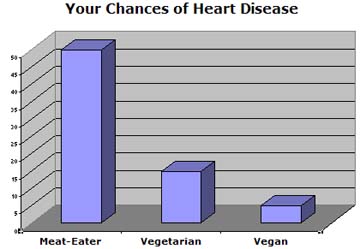
This chart shows the relative incidence of heart disease between a person who eats meat,
a vegetarian who eats eggs and dairy products (i.e. animal byproducts), and a vegan (who eats no animals and no animal byproducts).
Seeing these facts, it's no wonder that the Journal of the American Medical Association has stated:
A vegetarian diet can prevent 97% of our coronary occlusions.
If you give up your unnatural meat-based diet, your chances of getting a heart attack greatly decrease,
as does the liklihood of getting cancer and diabetes. These are the three biggest killers of Americans.
The typical American meat-based diet is so overloaded with cholesterol that minor changes in diet,
such as switching from eating cows to eating birds and fish really do nothing as far as bringing one's cholesterol level
below the high-risk category. It's like bailing water from a sinking ocean-liner with a thimble.
Once your cholesterol level exceeds a safe level it doesn't matter by how much more you exceed it.
If you have two eggs for breakfast your cholesterol level is already so high that it doesn't really matter
if you eat more cholesterol the rest of the day.
The only diets which effectively lower one's cholesterol to safe levels are vegetarian and vegan diets.
|
 Cholesterol isn't the only undesirable ingredient in meat, milk, and eggs.
Due to the confinment of animals on the modern factory-farm, the animals are very susceptible to
outbreaks of disease -- which could spread like wildfire to all the animals housed together.
To guard against this, the meat industry administers antibiotics to the animals.
These antibiotics are often retained in the animals and passed on to the meat-eater.
Cholesterol isn't the only undesirable ingredient in meat, milk, and eggs.
Due to the confinment of animals on the modern factory-farm, the animals are very susceptible to
outbreaks of disease -- which could spread like wildfire to all the animals housed together.
To guard against this, the meat industry administers antibiotics to the animals.
These antibiotics are often retained in the animals and passed on to the meat-eater.
- Two of these drugs are suspected carcinogens.
- Twenty are suspected of causing birth defects.
- Six are suspected of causing mutations.
The meat that is considered too badly infected with cancer (some 15 million pounds a year)
is processed into hog and chicken feed: which means that the cancer cells are recycled
through the food chain and eventually end up on the meat-eater's plate.
|
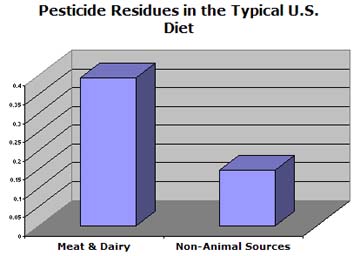
And let's not forget another important ingredient in meat and dairy products: pesticides!
Although most crops are sprayed with poisonous pesticides, most pesticide intake in the average American diet
comes from the eating of meat. This is because the animals store the pesticides spread on their food in their fat,
which is eventually consumed by the meat-eater.
|